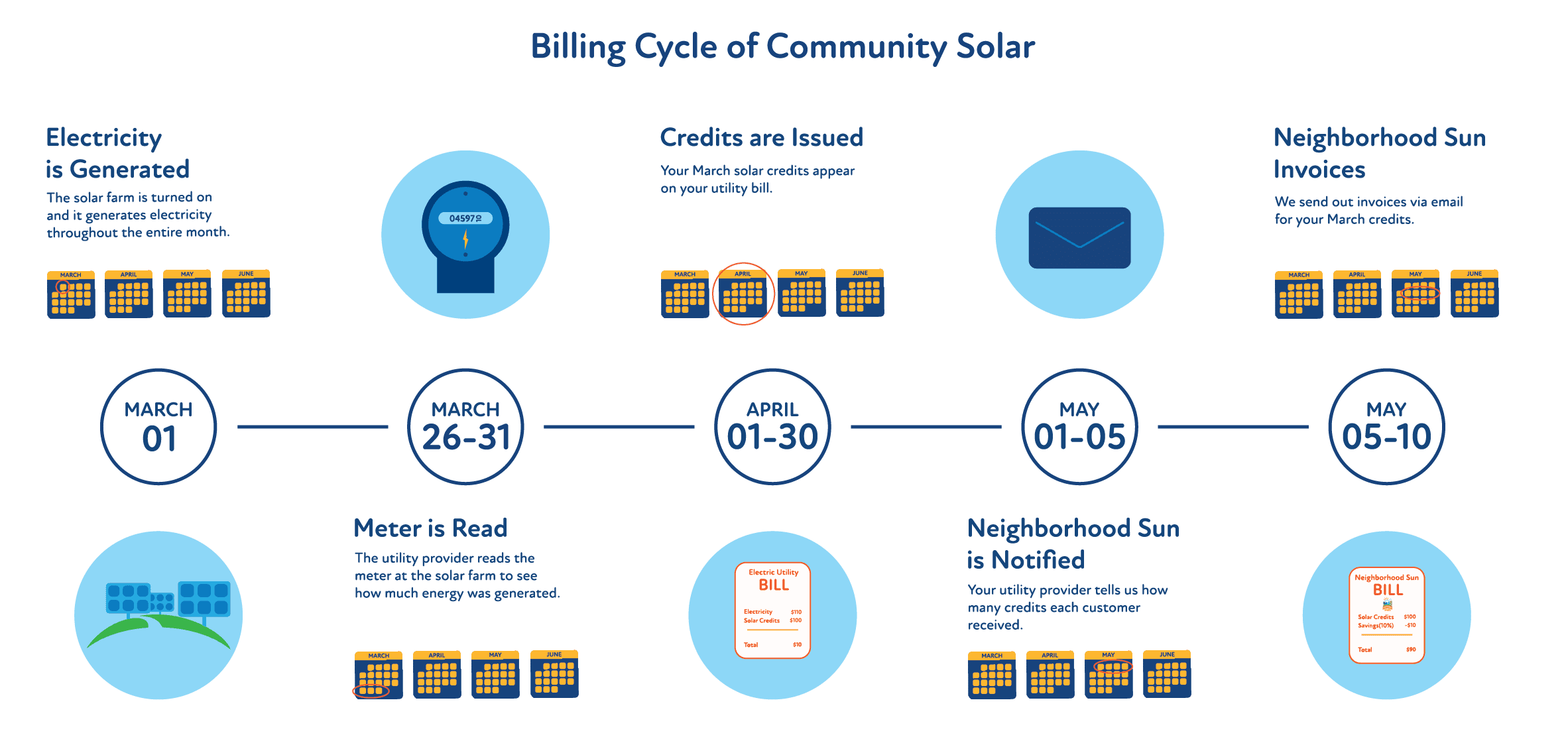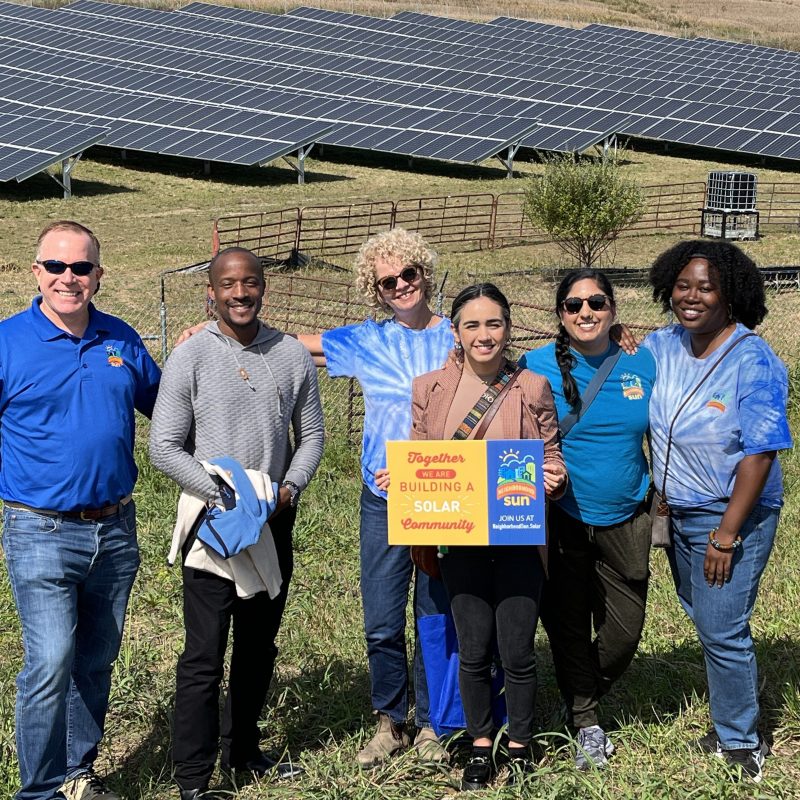It’s a local clean energy option that makes solar power available to renters and homeowners with no up-front costs or expensive solar panels. Community Solar picks up where traditional rooftop solar fails, distributing the benefits of clean energy to the people, rather than the utilities.
Through community solar programs, residents and businesses can subscribe to an off-site yet local community solar farm to receive a portion of the solar power it generates in the form of community solar credits on their utility bills. These credits reduce the total owed to a subscriber’s utility provider each month, and Neighborhood Sun applies a guaranteed discount to the credits, resulting in savings. This subscription model makes solar more inclusive, allowing anyone who pays a utility bill to access all the benefits of solar without any additional costs or installations needed.
Still skeptical of this win-win-win situation? Hear it straight from the U.S. Department of Energy, which defines community solar as any solar project or purchasing program, within a geographic area, in which the benefits flow to multiple customers such as individuals, businesses, nonprofits, and other groups.
Anyone who pays an electricity bill could be a subscriber. That means renters and homeowners alike. Live in a shady spot? It doesn’t matter. Live in affordable housing? You might even be eligible for a bigger discount. The main limitation is availability, so reserve your share while you can!
As a Neighborhood Sun subscriber, you’ll continue to receive your same utility bill. Neighborhood Sun’s community solar credits (which are generated by your “share” of a community solar farm in your utility territory) will be included on your current utility bill, reducing your total energy cost.
If you reside in a state with dual-billing, you will receive a separate bill from Neighborhood Sun for the credits you saw on your utility bill, which you pay Neighborhood Sun for at a discount, leading to savings when you consider the sum of both bills. In states with consolidated billing like New York, there is no need for the separate bill, so you just see the credits reducing your utility bill and don’t have to worry about anything else.
There is no catch. You get to support solar and save money each time you pay your electricity bill through this state-supported program. That’s the beauty of community solar. Don’t believe us? We get it. We think everyone should be a cautious and conscious consumer these days, so read up about community solar for yourself.
The U.S. Department of Energy defines community solar as any solar project or purchasing program, within a geographic area, in which the benefits flow to multiple customers such as individuals, businesses, nonprofits, and other groups.
According to the National Renewable Energy Laboratory, as of the end of 2023:
When you go through the sign-up process, you authorize us to review your historical electrical use. We use the past 12-24 months of your electric history to calculate the average amount of kWh you will need each month. Payments are based on the amount of electricity generated by your portion of the solar farm, not your actual kWh use.
All you need to do to cancel is fill out our Cancellation Form.
There is no fee to cancel, but you are responsible for paying for any credits that are applied to your bill until the cancellation is processed. With the way the utility billing cycle works, this period may last 60-90 days as you pay off the credits that have already been applied to your bill.
It’s free and easy to sign-up online. We need a few things to enroll you to a local community solar farm:
You can email hello@neighborhoodsun.solar or call us at (888) 698-3613. We’re available Monday to Friday from 9:30 a.m. to 5:30 p.m. ET. If you cannot immediately connect with someone, don’t worry- a team member will reach back out to you.
No, that’s the beauty of community solar! Anyone who pays an electricity bill (including renters) can participate because there are no installations or homeownership requirements.
Yes, if you have solar panels installed on your residence and they don’t generate 100% of your energy, you can subscribe to community solar with Neighborhood Sun. Your “share” of the community solar farm’s output will be based on the additional energy that is being supplied by the utility so it will be a smaller share of the solar farm
Anyone who pays an electricity bill could be a subscriber. That means renters and homeowners alike. Live in a shady spot? It doesn’t matter. Live in affordable housing? You might even be eligible for a bigger discount. The main limitation is availability, so reserve your share while you can!
Visit the MySolar portal to view all your past bills, monthly savings, and environmental impact!
We’ll email you at the start of each month to remind you of your auto-billing. Note that your invoice amount may fluctuate from month-to-month. This is because your share of the solar farm may produce more electricity in say June (sunny days!) than in January (typically less sun).
You will receive an invoice for your solar credits after the utility applies them to your electric bill. It usually takes between 30 to 60 days to receive your Neighborhood Sun invoice for the credits applied to your bill. Typically, you will receive your invoice on the 15th of the month, and it will be automatically processed seven days later. Please be aware that there may be delays in receiving the solar credit data from the utility provider. Rest assured, we will notify you via email if any delays occur!
Yes, your electricity bill will show a credit for the “share” of solar energy generated by your community solar farm and allocated to you. There is no change to your utility service. If you live in a state with dual-billing, you’ll receive a monthly invoice from Neighborhood Sun for the cost of your solar credits, but your discount will be applied, saving you money on your total monthly electricity costs.
Maryland’s 7-year Pilot Community Solar Program began in 2015 and was extended in 2019, resulting in enough solar capacity to support ~90,000 local households. In April 2023, Maryland’s state legislature passed HB 908 , making the pilot program permanent. The bill also allows for unlimited solar capacity and requires 40% of a project’s output to serve Low- and Moderate-Income (LMI) subscribers.
New York’s Community Solar Program began in 2015 as part of the Shared Renewables Program, an initiative to help make clean, affordable energy accessible for all types of New Yorkers. It’s a state-supported program, and New York is leading the country in community solar, with more than two gigawatts (GW) of community solar installed in New York as of December 2023 – enough to power nearly 400,000 homes.
New Jersey’s Board of Public Utilities (BPU) launched the pilot Community Solar Program in January 2019. With more than 19,000 subscribers in the Pilot Program who enjoyed $3 million in net bill savings, New Jersey celebrated the success of its pilot program, making its community solar program permanent on August 16, 2023. In January 2024, Governor Phil Murphy signed A4782/S3123 bill, which simplifies the community solar application and billing processes while making more capacity available and requiring that at least 51 percent of the power generated goes to low- and moderate-income subscribers. New Jersey subscribers can now benefit from consolidated billing, which means your community solar credits will be reflected directly on your utility bill and you won’t need to pay Neighborhood Sun separately for credits.
Colorado was the first state in the nation to pass community solar legislation in 2010. Since Colorado’s Community Solar Program began, 183 megawatts of solar have been installed. The inclusive community solar capacity ordered by 2024’s Access to Distributed Generation bill (SB24-207) is the latest step in Colorado’s efforts to increase access to solar. Under the new legislation, 51 percent of a solar farm’s generation capacity must be reserved for income-qualified subscribers. In 2026, subscribers will be able to self-attest their income, improving equity and accessibility.
Neighborhood Sun is a subscriber organization that oversees your enrollment to community solar farms in the Xcel territory through Colorado’s Solar* Rewards program, which is the nation’s largest community solar program. Click here to see Neighborhood Sun listed on Xcel’s website as a solar garden provider.
Community solar has been developing in Maine since 2009, when the state passed the Community-based Renewable Energy Pilot Program. Community solar, also known as Net Energy Billing (NEB) in Maine, is designed to promote the expansion of local solar production. Eligible solar farms receive credit for each kWh of electricity they generate. Utility customers can sign up with the owner of a solar project to receive a share of these credits generated by the solar farm. As of July 2024, Maine has 453 community solar farms totaling 630 megawatts of operational solar energy.
The Solar Massachusetts Renewable Target (SMART) Program is DOER’s incentive program established to support the development of solar in Massachusetts. As of early 2024, Massachusetts has 569 MWh of installed energy storage and 8,806 MWh under development. The state’s goal is to reach 1,000 MWh by December 31, 2025.
The legislation to create D.C.’s Community Solar Program was passed unanimously by the D.C. Council in 2013. The Solar for All program was implemented to electricity bills by about 50% for 100,000 low- to moderate (LMI) income households in D.C. by 2032. The program currently includes over 160 community renewable energy facilities that serve more than 6,000 LMI households.
Minnesota’s Community Solar Gardens program began in 2013 with unlimited capacity. In 2023, HF 2310 was passed by legislation to expand the program while enforcing new rules and limitations. Currently, community solar is only available to households that get their electricity from Xcel, and it is administered by the Minnesota Department of Commerce. A total of 55 percent of each garden’s capacity is reserved for Low- and Moderate-Income (LMI) households, affordable housing, and ‘public interest’ groups (such as nonprofits and libraries).

We’re a small team, but we address every single question with the utmost care. The quickest way to address your concern is by filling out the form below so a dedicated member of our support team will reach out to you as soon as possible.
(888) 606-0054
Need to cancel your community solar subscription? Please fill out the form here:
